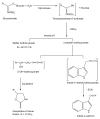Cruciferous vegetables and human cancer risk: epidemiologic evidence and mechanistic basis
- PMID: 17317210
- PMCID: PMC2737735
- DOI: 10.1016/j.phrs.2007.01.009
Cruciferous vegetables and human cancer risk: epidemiologic evidence and mechanistic basis
Abstract
Cruciferous vegetables are a rich source of glucosinolates and their hydrolysis products, including indoles and isothiocyanates, and high intake of cruciferous vegetables has been associated with lower risk of lung and colorectal cancer in some epidemiological studies. Glucosinolate hydrolysis products alter the metabolism or activity of sex hormones in ways that could inhibit the development of hormone-sensitive cancers, but evidence of an inverse association between cruciferous vegetable intake and breast or prostate cancer in humans is limited and inconsistent. Organizations such as the National Cancer Institute recommend the consumption of five to nine servings of fruits and vegetables daily, but separate recommendations for cruciferous vegetables have not been established. Isothiocyanates and indoles derived from the hydrolysis of glucosinolates, such as sulforaphane and indole-3-carbinol (I3C), have been implicated in a variety of anticarcinogenic mechanisms, but deleterious effects also have been reported in some experimental protocols, including tumor promotion over prolonged periods of exposure. Epidemiological studies indicate that human exposure to isothiocyanates and indoles through cruciferous vegetable consumption may decrease cancer risk, but the protective effects may be influenced by individual genetic variation (polymorphisms) in the metabolism and elimination of isothiocyanates from the body. Cooking procedures also affect the bioavailability and intake of glucosinolates and their derivatives. Supplementation with I3C or the related dimer 3,3'-diindolylmethane (DIM) alters urinary estrogen metabolite profiles in women, but the effects of I3C and DIM on breast cancer risk are not known. Small preliminary trials in humans suggest that I3C supplementation may be beneficial in treating conditions related to human papilloma virus infection, such as cervical intraepithelial neoplasia and recurrent respiratory papillomatosis, but larger randomized controlled trials are needed.
Figures



Similar articles
-
Cruciferous vegetables: cancer protective mechanisms of glucosinolate hydrolysis products and selenium.Integr Cancer Ther. 2004 Mar;3(1):5-12. doi: 10.1177/1534735403261831. Integr Cancer Ther. 2004. PMID: 15035868 Review.
-
Intake of total cruciferous vegetable and its contents of glucosinolates and isothiocyanates, glutathione S-transferases polymorphisms and breast cancer risk: a case-control study in China.Br J Nutr. 2020 Sep 28;124(6):548-557. doi: 10.1017/S0007114520001348. Epub 2020 Apr 20. Br J Nutr. 2020. PMID: 32308174
-
Effects of cruciferous vegetables and their constituents on drug metabolizing enzymes involved in the bioactivation of DNA-reactive dietary carcinogens.Mutat Res. 2001 Sep 1;480-481:285-97. doi: 10.1016/s0027-5107(01)00188-9. Mutat Res. 2001. PMID: 11506821 Review.
-
Cruciferous vegetables and colo-rectal cancer.Proc Nutr Soc. 2006 Feb;65(1):135-44. doi: 10.1079/pns2005486. Proc Nutr Soc. 2006. PMID: 16441953 Review.
-
Research on cruciferous vegetables, indole-3-carbinol, and cancer prevention: A tribute to Lee W. Wattenberg.Mol Nutr Food Res. 2016 Jun;60(6):1228-38. doi: 10.1002/mnfr.201500889. Epub 2016 May 23. Mol Nutr Food Res. 2016. PMID: 26840393 Free PMC article. Review.
Cited by
-
Modulation of natural killer cell antitumor activity by the aryl hydrocarbon receptor.Proc Natl Acad Sci U S A. 2013 Jul 23;110(30):12391-6. doi: 10.1073/pnas.1302856110. Epub 2013 Jul 8. Proc Natl Acad Sci U S A. 2013. PMID: 23836658 Free PMC article.
-
Cruciferous vegetables intake and the risk of colorectal cancer: a meta-analysis of observational studies.Ann Oncol. 2013 Apr;24(4):1079-87. doi: 10.1093/annonc/mds601. Epub 2012 Dec 4. Ann Oncol. 2013. PMID: 23211939 Free PMC article.
-
Pharmacokinetics and pharmacodynamics of 3,3'-diindolylmethane (DIM) in regulating gene expression of phase II drug metabolizing enzymes.J Pharmacokinet Pharmacodyn. 2015 Aug;42(4):401-8. doi: 10.1007/s10928-015-9421-5. Epub 2015 Jul 3. J Pharmacokinet Pharmacodyn. 2015. PMID: 26138223
-
Sulforaphane-enriched extracts from glucoraphanin-rich broccoli exert antimicrobial activity against gut pathogens in vitro and innovative cooking methods increase in vivo intestinal delivery of sulforaphane.Eur J Nutr. 2021 Apr;60(3):1263-1276. doi: 10.1007/s00394-020-02322-0. Epub 2020 Jul 10. Eur J Nutr. 2021. PMID: 32651764 Free PMC article.
-
Structural interactions dictate the kinetics of macrophage migration inhibitory factor inhibition by different cancer-preventive isothiocyanates.Biochemistry. 2012 Sep 25;51(38):7506-14. doi: 10.1021/bi3005494. Epub 2012 Sep 11. Biochemistry. 2012. PMID: 22931430 Free PMC article.
References
-
- Kristal AR, Lampe JW. Brassica vegetables and prostate cancer risk: a review of the epidemiological evidence. Nutr Cancer. 2002;42:1–9. - PubMed
-
- Drewnowski A, Gomez-Carneros C. Bitter taste, phytonutrients, and the consumer: a review. Am J Clin Nutr. 2000;72:1424–35. - PubMed
-
- Holst B, Williamson G. A critical review of the bioavailability of glucosinolates and related compounds. Nat Prod Rep. 2004;21:425–47. - PubMed
-
- Zhang Y. Cancer-preventive isothiocyanates: measurement of human exposure and mechanism of action. Mutat Res. 2004;555:173–90. - PubMed
-
- Liu RH. Potential synergy of phytochemicals in cancer prevention: mechanism of action. J Nutr. 2004;134:3479S–85S. - PubMed
Publication types
MeSH terms
Substances
Grants and funding
LinkOut - more resources
Full Text Sources
Other Literature Sources
Medical

